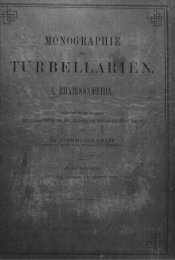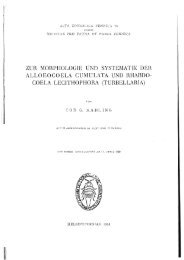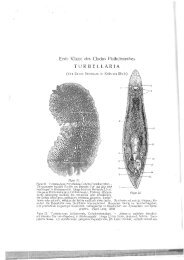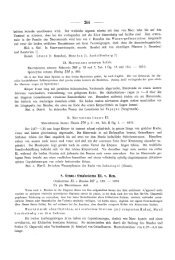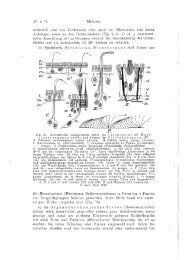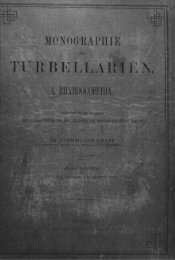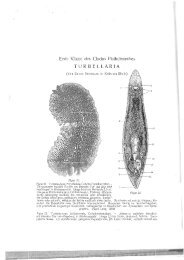Kleinturbellarien aus dem Litoral der Binnengewässer Schleswig ...
Kleinturbellarien aus dem Litoral der Binnengewässer Schleswig ...
Kleinturbellarien aus dem Litoral der Binnengewässer Schleswig ...
Sie wollen auch ein ePaper? Erhöhen Sie die Reichweite Ihrer Titel.
YUMPU macht aus Druck-PDFs automatisch weboptimierte ePaper, die Google liebt.
530 Jens-Uwe Rixen<br />
Frühlingstümpel bedingt, das zweite im August resultiert <strong>aus</strong> <strong>der</strong> großen<br />
Zahl <strong>der</strong> sich zu dieser Zeit entwickelnden Phytalbewohner.<br />
Summary<br />
1. The present study deals with previously nearly unknown microturbellaria<br />
of <strong>Schleswig</strong>-Holstein. In or<strong>der</strong> to obtain a complete survey of<br />
the object of this treatise, all findings of microturbellaria in our country<br />
published hitherto are summarised.<br />
2. Forty-four of the 69 obtained species (p. 468 f.) have not yet been<br />
found in Sch1eswig-Holstein, 15 are new to Germany as a whole. Two of<br />
them are new to science (Rhynchoscolex remanei and Macrostomum subterraneum),<br />
a third species (Provorticidorum spec.) is only described pro<br />
visionally due to lack of material.<br />
3. In the systematic-autecological part of this paper the circumstances<br />
of the findings of the individual species are listed. Whenever possible,<br />
their ecological <strong>dem</strong>ands have been analysed, and zoogeographical problems<br />
treated. When necessary taxonomical facts have been added.<br />
4. The high percentage of new species found for <strong>Schleswig</strong>-Holstein<br />
and Germany <strong>dem</strong>onstrates the deficiency in our knowledge of the distri<br />
bution of microturbellaria. Therefore one must excercise caution in the use<br />
of hitherto published zoogeographical characterisations of some species<br />
(especially according to Otomesostoma auditivum, Castrada sphagnetorum,<br />
Castrada viridis, Koinocystis neocomensis).<br />
5. The comparative-ecological part deals with the distribution of the<br />
<strong>Schleswig</strong>-Ho1stein microturbellaria fauna within the different biotopes.<br />
The studied biotopes are springs, sandy banks of rivers, standing waters<br />
(divided in phytal, muddy biotopes, psammal, subterranean interstitia1<br />
system), moor biotopes, wood and meadow ponds, and some waters of<br />
an aberrant chemism. From the latter group the Oldesloe salt marshes<br />
have been consi<strong>der</strong>ed especially.<br />
6. Two species are real ubiquists (Gyratrix hermaphroditus and Stenostomum<br />
leucops), some others (tab. 8, group B) properly eurotopic. With regard<br />
to still other species, one is ab1e to arrange certain groups to preferred<br />
biotopes, as subterranean interstitia1 system, psammal, phyta1, verna1 ponds,<br />
and moor biotopes (tab. 8, groups C-Q). In the Oldesloe salt ponds some<br />
thalassogene species have been found for the first time inland, far from<br />
the sea in salt water (Macrostomum hystricinum, Macrostomum tenuicauda,<br />
Placorhynchus octaculeatus dimorphis, Bresslauilla relicta).<br />
7. Diatoms have been <strong>dem</strong>onstrated to be an important food of many<br />
bottomliving species. The animals of the phytal feed on Rotatoria bdelloidea<br />
to a high degree.



